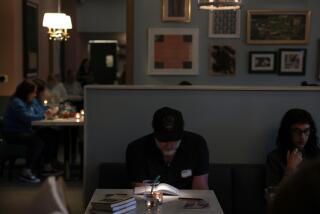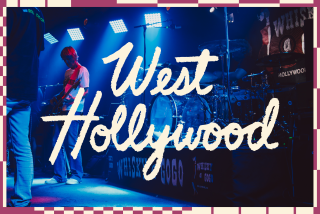HAMPSTEAD INSTEAD
- Share via
LONDON — When a man is tired of London, Samuel Johnson famously suggested in 1777, he is tired of life. What Johnson neglected to mention, however, is that then, as now, London’s smart set had a ready remedy for city-weariness: a retreat to Hampstead.
The village and heath of Hampstead, just minutes from central London by subway, for centuries has stood above and apart from the rest of the city. In centuries past, Londoners came here to escape the plague, to buy clean water and to see the uncompromised countryside of Hampstead Heath, whose rolling hills remain undeveloped and protected. These days, Hampstead is a small world of hip storefronts, historical overtones, generous parkland and high-end residences, where oil-rich Arabs live around the corner from pop-music stars. It is a place where, one way or another, one can bump into Karl Marx, Sigmund Freud, John Keats, Mary Poppins and Boy George.
But for most foreigners, the appeal of Hampstead is probably more than the sum of its commerce, its residences and its celebrity imprimatur. During the three days my wife and I spent in the neighborhood last August, the bonus for me was its sense of self-containment. That can be a deep relief for a visitor who has spent too many days contending with the crowds, traffic and vast sprawl of London.
The spine and shoulder blades of Hampstead are Hampstead High Street and Heath Street. They house art galleries, trendy restaurants, the Yankee Doodle American clothing store, design shops teeming with bright colors, ‘60s nostalgia and $80 lava lamps and, less fetching, several latecomers to the neighborhood, such as Nachos Restaurant (“since 1990”) and a McDonald’s.
But it’s easy enough to concentrate on the historic and the fashionable. Along Flask Walk, where 19th century Londoners came to buy spring water, organic butcher J.A. Steele’s shingle hangs across the alley from Keith Fawkes’ shop full of secondhand books, and a guitar player sits on a step, straining to tame a flamenco melody.
On Church Row, strollers pass H.G. Wells’ old house (No. 17) and explore the graveyard of St. John’s Church. At the far end of the property one afternoon, my wife, Mary Frances, and I turned a corner to find the body of a bony, pale woman in a black bikini. Not dead. Alive and tanning, between two headstones. We passed in silence, lest she roll over to reveal glowing eyes or long fangs.
Near the edge of the heath off Downshire Hill stands Keats’ House, where the poet lived for a couple of years in the early 19th century before his death at age 26. Admission is free; the interior fairly spartan. But in the front yard, by some greenery, stands perhaps the most scrupulously honest tourist sign I’ve ever seen: “This plum tree replaces the one beneath which John Keats wrote “Ode to a Nightingale.”
Just off Heath Street on Hollybush Vale, attesting to the neighborhood’s Bohemian tradition, stands Everyman Cinema, an art house that calls itself “the oldest repertory cinema in the world.” During our visit features included “Faster Pussycat! Kill! Kill!” and “La Dolce Vita” and “The Unbearable Lightness of Being.”
The Everyman has its own bar next door, but choosing a venue for a drink is no easy task. In the space of a few Hampstead blocks, one passes the Flask, the Coach & Horses, the Horse & Groom, the King of Bohemia, the Duke of Hamilton and the King William IV. I liked the Flask’s location best because it stands on a pedestrian street. Safer for staggerers.
The heath of Hampstead is about 800 acres, sloping, partly wooded, generally unmanicured. Like an off-center Central Park, it accommodates performing arts stagings, a few landmark buildings, scenic bodies of water (28 natural ponds, some still used by bathers), and in some shady corners, especially after dark, gay trysters.
*
On the Saturday afternoon that I walked its main paths, the place was full of purple flowers, green-brown lawns, panting sheep dogs and scores of reclining melanin-challenged Londoners soaking up what they could of the sunny day.
After about a half an hour of walking, I climbed a hill for an overview, and imagined I heard a swell of brass and a rolling kettledrum. There on a slope to my left presided Kenwood House, a stately, beige 18th century mansion now open to the paying public. Ahead of me lay a pond. Upon it, skittering ducks. And beyond the ducks lay proof that I wasn’t imagining that brass and percussion. There sat 70 or so members of the Royal Philharmonic Orchestra in shirt sleeves, practicing Elgar’s Symphony No. 1 before a performance that night.
All was in its place. At any moment, I expected the voice of Sir John Gielgud to come echoing down from the heavens, declaiming Shakespeare’s lines from “Richard II” on the majesty of “this blessed plot, this earth, this realm, this England.”
When that didn’t happen, I wandered into the Kenwood House, past works of Thomas Gainsborough Sir Joshua Reynolds Frans Hals Jan Vermeerand a late Rembrandt self-portrait. Not bad for never leaving the neighborhood.
Hampstead is, however, lodging-poor. Having arranged to join friends from Oxford, Mary Frances and I had blindly selected a neighborhood restaurant and hotel on Heath Street called La Gaffe.
Its location was convenient, and its windows were double-glazed to limit street noise. But it had no elevator, a narrow stairwell, and some very tiny rooms with even tinier bathrooms. Still, for every creature comfort it lacked, La Gaffe did seem to offer another dollop of charm.
Bernardo Stella, the proprietor and a fixture in the neighborhood for more than 30 years, also writes, and several of his verses hang framed on La Gaffe’s walls. Thus, rushing out to dinner or sauntering down to breakfast, a guest may pause to consider a few rhyming lines on birds, rain, forbidden love, or the celebration of Queen Elizabeth’s 25th year on the throne in 1977.
“So much is written and said about your jubilee/That the bug has finally gotten into me,” that last poem begins. It ends with a call for the queen to remain “as fresh and pure as the early morning dew,” and is framed along with a reply from Buckingham Palace. The queen, her secretary wrote, “was interested to see this and much appreciated the sentiments.”
You just don’t see that at a Hyatt. On the other hand, at the Hyatt you may have room to open your suitcase all the way without positioning it in the middle of the bed.
*
Our itinerary gave us a Sunday in Hampstead--which does not mean a day of rest. We hit three of the area’s leading tourist attractions, and were soon awash in reminders of youth, death and the unconscious mind.
First came the foray to the market at Camden Locks, along Camden High Street. This neighborhood, a three-stop subway ride from Hampstead, 25 years ago was known as a blue-collar commercial strip being gentrified by media types and artisans. Now, thousands of youths crowd into hundreds of stalls each weekend to peruse leather jackets amid throbbing soundtracks. Camden, we found, has evolved into a dead-on anglicized Melrose Avenue, from the outlandish storefronts to the purple-haired youth slouching in doorways.
The marketplace has spread from the immediate area of the canal locks to include a Stables Market up the street, an Electric Market down the street, and a staggering neighborhood inventory of batiks, jewelry, antiques, quasi-antiques and pop fashion. Slinking away after an hour or so, we agreed that we, in our mid-30s, were about 15 years too old to appreciate the scene fully. Perhaps Highgate Cemetery would be more our speed.
Lying about one mile northeast of the Hampstead subway station, Highgate is London’s most famous burial ground, and is often described as a magical place--although I’d sooner label it eerie and ironic.
Together, Highgate’s east and west sections hold more than 166,000 19th and 20th century graves, most notably that of Karl Marx. On summer days, tourists by the hundreds arrive to pay about $1.60 for entrance to the public portion of the cemetery (the closed portion is opened only for one escorted tour daily), then fan out among the rampaging vegetation, tumbled-down markers and meandering paths in search of a 4-foot-high head of stone atop an 8-foot base. In case the familiar wild beard isn’t enough to give the game away, the gold-leaf inscription makes clear who lies below:
“WORKERS OF ALL LANDS UNITE. THE PHILOSOPHERS HAVE ONLY INTERPRETED THE WORLD IN VARIOUS WAYS. THE POINT, HOWEVER, IS TO CHANGE IT.”
Marx died in 1883, his funeral attended by 11 people. (The impressive grave marker didn’t come until about 70 years later.) At first, I wondered how much trouble Marx’s family had finding a cemetery to admit such a famous atheist. But that, the literature on sale at the entrance explained, had been no problem.
From its inception in 1839, Highgate was a commercial enterprise and unaffiliated with any particular church. For decades it was the most fashionable funeral address in London, accommodating the family of Charles Dickens (the writer is entombed beneath Westminster Abbey), Mary Ann Evans (better known as the novelist George Eliot), and various captains of industry and leaders of academe. But its popularity passed. Maintenance lagged, and the business failed.
By 1975, when a nonprofit organization took over, the cemetery had deteriorated into a jungle, paths impassable, sycamore trunks rising like ghost-story apparitions from cracked-open tombs. By the account of one writer, the cemetery “became a favorite haunt for vandals, grave robbers, Satanists and harmless spooks after a few beers at the local pub.”
Even now, despite an endowment of more than $750,000 and the income from tourists and burials (new graves are still being dug), the place is like a Stephen King story in Sensurround. The Friends of the Highgate Cemetery say the best they can do is to preserve it as they found it, with no hope of restoration.
*
The afternoon was just about gone now, but I knew the Freud Museum would be closed the following day, a Monday, so we hailed a taxi and dashed over to the luxurious home at 20 Maresfield Gardens, near the Finchley Road subway stop. Admission was about $5.
The main thing, of course, was to see the couch. There it was, draped, as in its working years, by a Persian rug. Sigmund Freud, already 82 and ailing from cancer, arrived here in 1938, having fled Vienna to avoid the Nazis. He died almost exactly a year after his arrival at Maresfield Gardens, and his daughter, Anna, lived in the house, practicing psychoanalysis and running a children’s clinic until her death in 1982.
The residence was opened as a museum in 1986, and aside from the couch and his desk, with a pair of glasses laid upon the blotter, it includes the father of psychoanalysis’ beloved collection of 2,000 Greek, Roman and Egyptian artifacts that cover almost every flat surface in his office. It’s an interesting sensation to look on that couch, those glasses, those artifacts, and then hear the doctor’s thickly accented voice.
“I had to pay heavily for this bit of good luck,” the doctor says on an old recording the museum plays regularly. “People did not believe in my facts and thought my theories unsavory.”
*
Our encounters with a Hampstead celebrity began on our first afternoon there. We had gathered in La Gaffe’s wine bar to lay plans. The walls were crowded with theater posters and book-heaped shelves. One of the books, prominently displayed, was written by BBC war correspondent Martin Bell, the approximate U.K. media equivalent to CNN’s Wolf Blitzer.
This volume sparked speculation that Bell must come in occasionally. Suddenly, our conversation stalled, our Oxford friends murmuring and glancing significantly at a pedestrian just outside the window. Bell himself, strolling past.
Later, Bernardo Stella volunteered to give me a driving tour of the neighborhood. We started a block uphill from La Gaffe with the four-story house, its roof designed to resemble a ship’s quarterdeck, where “Mary Poppins” was filmed. In the house next door, novelist and playwright John Galsworthy once lived.
“In the 1960s and ‘70s, this was Bohemia,” Stella told me. “Now,” he said, perhaps thinking of the chain restaurants on the main drag, “it’s getting Americanized.”
From here, the tour advanced rapidly: The former orphanage where French Gen. Charles de Gaulle stayed during part of World War II (No. 99 Frognal). The vacation home of King Constantine of Greece, and the ambassadorial residences of Egypt, Paraguay and Russia. Not far from there, at Squires Mount, a former residence of Richard Burton and Elizabeth Taylor (nice flowers on the rooftop terrace). At the brown-brick manse of Boy George, we paused to read a graffito scratched on the high wall: “Thank you for being you!”
Between homes of the stars Stella offered stories: the lonely Hampstead high roller who, it is rumored, occasionally arranged for a prostitute to visit from New York at $10,000 a night; the dining habits of neighbor Peter O’Toole, who took dinner at La Gaffe on a night we chose to dine down the street.
I wasn’t really done with Hampstead yet. I hadn’t looked at the old musical instruments in the 17th century Fenton House mansion, hadn’t seen a Briefly Shakespeare Company performance (“Hamlet,” in an hour) atop the heath at Jack Straw’s Castle. But we were out of time.
We were at the end of a demanding trip, and we were tired of lugging bags, tired of airports and train stations, perhaps even a bit tired of London. But we were not tired of Hampstead.
(BEGIN TEXT OF INFOBOX / INFOGRAPHIC)
GUIDEBOOK
Hip, Historic Hampstead
Getting there: Hampstead is in North London, minutes by the Underground or bus from central London. A one-way fare on the “tube” is about $1.60 at current exchange rates.
Where to stay: Choices are few and modest, but (by London standards) affordable. At La Gaffe (telephone 011-44-171-435-8965, fax 011-44-171-794-7592), there are 18 small rooms in an 18th century building above a popular Italian restaurant. Rooms for two run about $112-$155, buffet breakfast and England’s 17.5% value-added tax included. Down the hill a few blocks from Hampstead proper, the modest, clean Rosslyn House Hotel (tel. 011-44-171-431-3873, fax 011-44-171-433-1775) offers 16 rooms, with doubles about $86, continental breakfast and VAT included. Farther down the same hill stands a Forte Posthouse (tel. 011-44-171-794-8121, fax 011-44-171-435-5586), essentially a Holiday Inn with a British accent. It has 140 rooms, a restaurant and a clientele of mostly business travelers; double rooms are about $110 on most weekends.
Where to eat: Other than La Gaffe (see above), a neighborhood favorite is the Cafe des Arts (82 Hampstead High St.; local tel. 435-3608). Entrees: about $13-$23. Graffiti (71 Hampstead High St.; tel. 431-7579) offers Mediterranean cuisine and excellent people-watching. Entrees about $13-$19. L’Altro (108 Heath St.; tel. 794-9919) offers Italian fare in a sophisticated dining room. Entrees about $17-$32. Cafe Mozart (17 Swains Lane; 181-348-1384), just down the hill from Highgate Cemetery, is a casual spot for lunch. All entrees under $13.
For more information: British Tourist Authority, 551 5th Ave., Suite 701, New York, NY 10176-0799; tel. (800) GO2 BRITAIN.
--C.R.
More to Read
Sign up for The Wild
We’ll help you find the best places to hike, bike and run, as well as the perfect silent spots for meditation and yoga.
You may occasionally receive promotional content from the Los Angeles Times.







